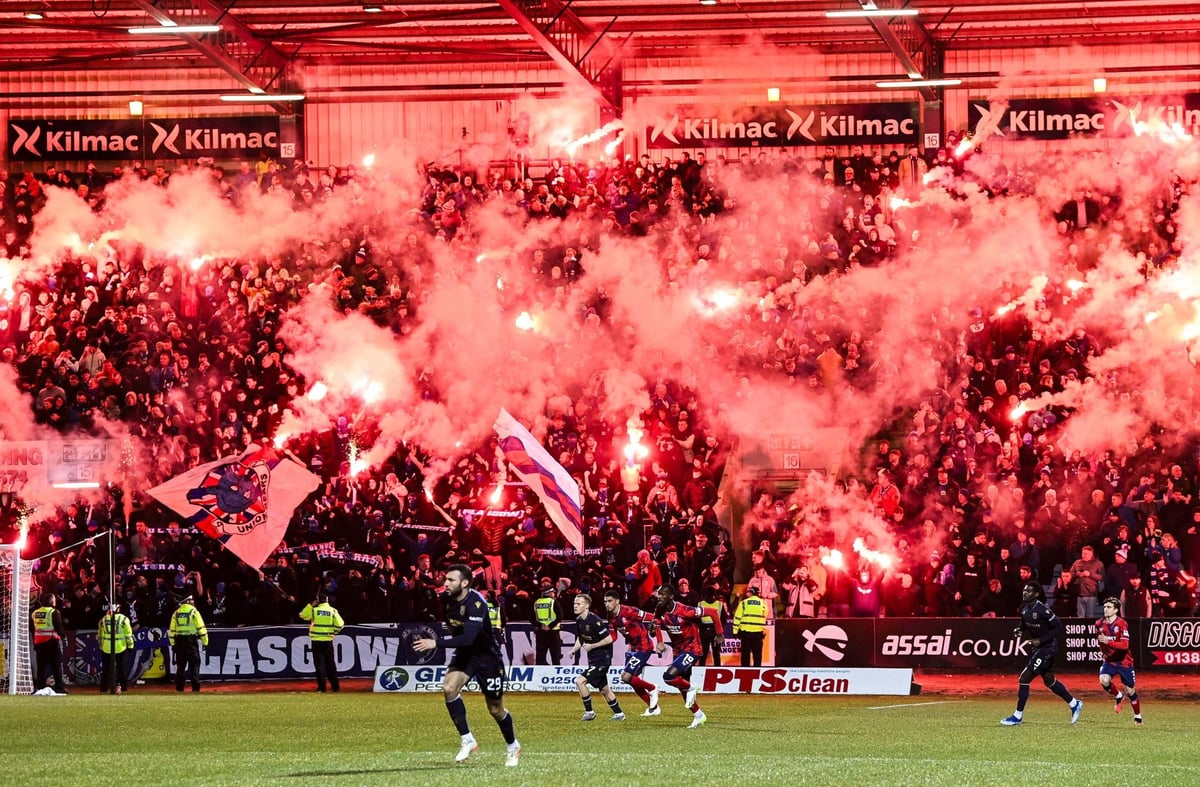© The Fan Experience Company 2023

'Education is the answer' to Scottish football's growing pyrotechnics issue
The use of pyro was recorded at more than 25% of Uefa matches six years ago. Anyone with half an eye on European football will know that number has surely risen, and Scotland falls right into that category. So whether you are for or against it, now is probably the time to accept that flares, fireworks and smoke bombs are not going anywhere - but is there a remedy?
Is it safe to use a pyrotechnic, which can burn at a temperature of more than 1,000C, in a football stadium while standing just inches from a fellow fan?
The answer, unsurprisingly, is an “unequivocal” no. That’s according to an independent study commissioned by Uefa back in 2017.
But the bad news for Scotland’s football authorities is that does not mean they can just close their eyes and hope a growing issue on their hands will vanish into thin air like brightly coloured smoke from a canister.
The use of pyro was recorded at more than 25% of Uefa matches six years ago. Anyone with half an eye on European football will know that number has surely risen, and Scotland falls right into that category.
So whether you are for or against it, now is probably the time to accept that flares, fireworks and smoke bombs are not going anywhere – but is there a remedy?
“Education’s the answer,” Dr Tom Smith, who authored that Uefa report, tells BBC Scotland. “My worry, but also part of the solution, is I don’t think fans understand what the problems are because they can convince themselves that they’ve never had a problem.”
Meanwhile, Tommy Corsden – inventor of Tifontaine, the EU’s first safety-approved handheld flare – speaks at length on The Scottish Football Show as to why he believes his lower-temperature pyro can minimise risk, rather than unrealistically trying to eliminate it.
“It’s important that the debate goes on,” he adds. “The problems will not go away. They have to find a solution.”
Authorities failing to tackle ‘escalating’ issue
If it has not already, Scottish football’s problem with pyro is reaching breaking point. In June, new legislation making it a criminal offence to possess fireworks and flares at grounds came into force after May’s Scottish Cup semi-final between Celtic and Rangers was delayed because of smoke inside Hampden.
At the time, community safety minister Siobhian Brown said it was a “dangerous” issue which was “escalating” and that the measures were designed to tackle the problem. That tackle has been less of a two-footed cruncher and more of a feeble tug of the shirt.
Earlier this month, BBC Scotland learned that no Scottish club has ever been sanctioned by the SPFL for the use of fireworks or flares.
That came just after Rangers’ Premiership visit to Dundee was suspended for 18 minutes when a full stand display from the travelling fans engulfed Dens Park in smoke, causing a fire alarm to trigger.
Can you deny the spectacle of it? Probably not, but safety concerns and general inconvenience, given the match had already been delayed 45 minutes because of traffic issues, must also apply.
That night at Dens Park would have been high on the agenda when the Scottish FA and SPFL met this week to discuss their next steps. Figures from Police Scotland and the Scottish government were also present. There was no fan representation.
Given the appetite from a growing number of supporters to continue using pyro, plus those who have valid concerns, overdue communication with fans would perhaps be a decent starting point.
Why eliminating the problem is unrealistic
With the problem escalating, further pressure will inevitably be put on clubs to crack down. But the SFA and SPFL say they are encouraged for now by steps taken to combat the issue after their Hampden meeting.
Motherwell warned their fans they “could be subject to sanctions” after some supporters lit up the away end at St Johnstone’s McDiarmid Park just days after authorities promised a “range of steps” had been put in place to avoid a repeat of the Dens display.
To assume club statements would be enough in reducing the problem may be fanciful, though, so perhaps we can expect to be re-introduced to the term ‘strict liability’ in the near future.
The idea of adopting that strategy was floated in 2019 to deal with fan misbehaviour, but a BBC Scotland survey discovered just three SPFL clubs were in favour of being liable for the actions of their supporters.
It’s a method used by Uefa in their European competitions, but countless fines issued to clubs across the continent, including Scottish sides, appears to be doing little to minimise the issue.
Smith “wouldn’t be in favour of draconian searches” outside grounds, however he believes a way to prevent pyro is to “stop it being imported” into the country. “But that’s not easy,” he adds. Instead, he would rather the focus is put on highlighting the risks.
“The people using them need to know the danger,” he says. “It’s all very well doing something to yourself, but it’s different when you start putting other people at risk.
“A quick search on YouTube will show you dozens of incidents. A fan picking up a pyro and losing most of his hand when it exploded, a Croatian fireman losing three fingers, a French steward losing part of her foot.”
Can there be a middle ground?
It’s difficult to predict whether any further laws or sanctions would halt a soaring situation – given there’s currently legislation in place – so perhaps there’s a discussion to be had on minimising risk, rather than hoping it just goes away.
Corsden believes he can achieve that with his product, a lower-temperature pyro which burns at a heat that’s about four times cooler than an emergency flare.
But the Dane stresses this is not something to be toyed with, as they can still reach a temperature of 250C, but a heat-resistant handle and straightforward extinguishing makes the product “much less dangerous”.
A video from COPA90 shows the presenter running the flame through his hand and over the top of his head. The flame is also much smaller than one generated by a standard flare, while far less smoke is emitted, but that does not address the issue of close proximity.
MLS club Orlando City have tried to find an answer to that by introducing specific smoke device zones in their standing section.
But regulating and authorising such measures is difficult, as the Danes and Swedes have found. The roll-out of Tifontaine at Brondby in Denmark was halted by their fans as it required approval from the local council for each game.
Sweden also bought into the idea, buying more than 1,000 units, but police reportedly intervened to prevent the process going any further.
It’s uncertain whether both nations will attempt to push through their trials with the product, but what’s clear is that pyro is not going anywhere.
Like it or loathe it, you can expect to continue seeing the sight of illicit smoke at your Scottish ground of choice for the foreseeable until compromises are made or solutions reached.
Original article published 23.11.2023 on the BBC Sport website.
To view the full article, click here
